In the winter season of cold, snow and holiday music, the North American bird breeding and nesting season seems months away. It’s not until the trees begin to bud and flowers bloom that the birdsong fills the air.
And that’s true. But not for great horned owls.
Winter is the time to enjoy the great horned owl breeding season–a time when these charismatic birds are much easier to see and hear.
It’s the hooting season.
Don a winter cap and head out to your local park or walking trail to enjoy one of the season’s coolest spectacles. Here’s what you need for your next owl outing.
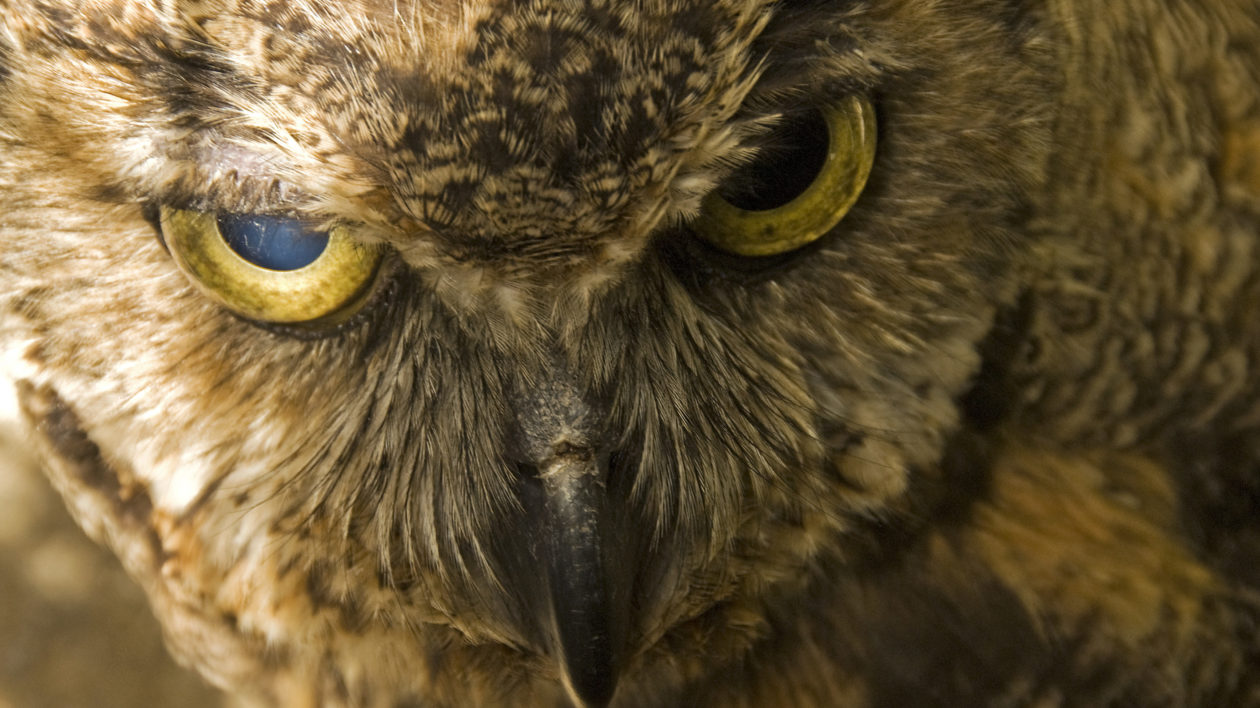
Into Owl Territory
The great horned owl, of course, is one of the most recognizable birds in the Americas, with its pointy feather tufts (the “horns”) and large fluffy appearance.
This is the prototypical “wise old owl,” and the owl of cartoons and children’s books.
It’s also incredibly adaptable, found from Canada to Patagonia, and most places in between. It is at home in desert and wetland, forest and prairie. And it also has no trouble thriving around people: you can find them in parks, farms, small woodlots, suburbs and cities.
Despite this, they’re not always easy to spot due to their nocturnal habits. But at this time of year, in the right location, a chorus of hoots provides the soundtrack to dawn and dusk.
That’s because, around October, male great horned owls begin setting up territories. Most great horned owls mate for life, but in the fall the pair begin a courtship display, loudly calling to each other.
Become a Member
Make a lasting impact for nature when you join The Nature Conservancy
The great horned owl’s hoot is pretty much unmistakable, although ornithology web sites often describe it in different ways. A common hooting pattern is a longer hoooooot, followed by two or three shorter hoots.
And these owls have a range of other vocalizations, too, some of which sound like barks or a screeching cat. (Cornell’s All About Birds site features some great audio of these different calls).
The owls continue setting up their territory this month, and begin setting up a nest.
They’ll use an abandoned nest previously used by a red-tailed hawk, squirrel or other critter. Come January, they’ll begin setting in the nest–far earlier than most other birds.
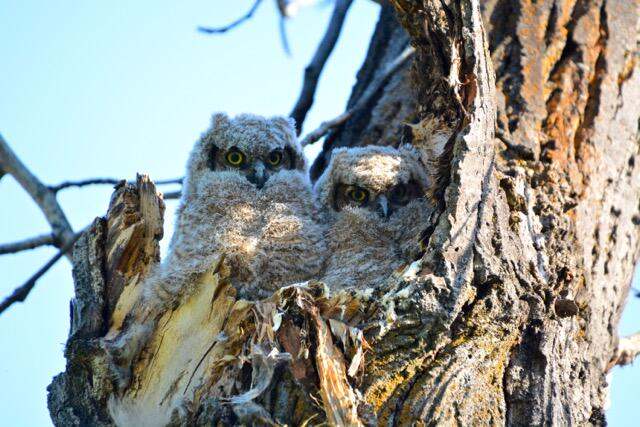
Why Do Owls Nest So Early?
Nesting early naturally entails some risk. Eggs must be kept warm and incubated, which can be a challenge when the temperature is in the single digits and snow is falling.
Female owls stay on the nest for prolonged periods (and when they leave to hunt, the male will take over).
If the eggs become too cold, they won’t hatch. This is why most birds wait until temperatures are warm and mild.
So: why nest early?
Owls are large birds. It takes them longer to grow and mature than, say, a songbird.
Young great horned owls must also master complex hunting maneuvers. They are equipped with superb senses – researchers have found that a great horned owl can hear a mouse rustling at 900 feet – but hunting still involves learning, trial and error.
Early hatching means they’re ready to practice their flying and hunting skills when the weather is mild and prey is abundant.
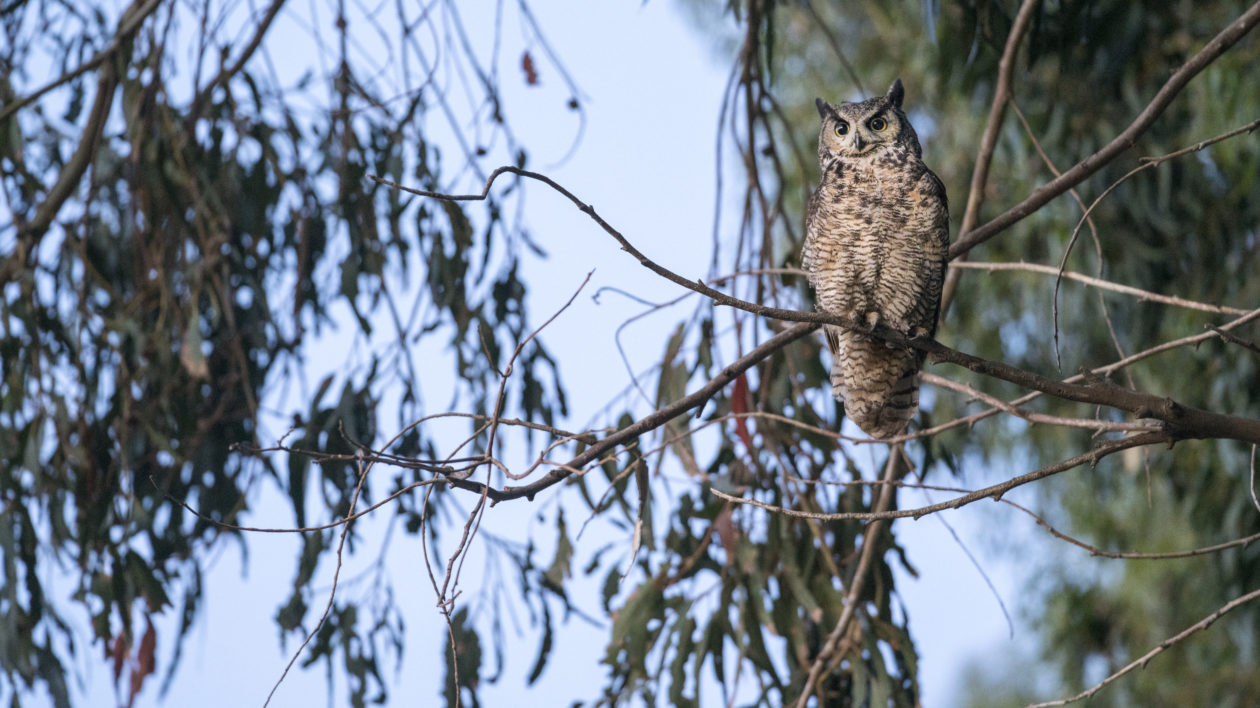
Enjoying the Owl Show
There’s likely a great horned owl territory near you. Now you just need to find it.
While owls can live in a variety of habitats, you won’t find them just anywhere. Focus on the edges. Owls prefer to have a good vantage point – a place where they can see out over the terrain.
Trees that overlook an open area are ideal. In particular, try to find a big-limbed tree that has shed its leaves (or a dead one). You can often find owls roosting there.
You can do a bit of scouting, too. Owls regurgitate the indigestible hair and bones of their prey: called owl pellets. You can often find a number of these pellets below preferred trees. (You can often reassemble the bones of mice by dissecting an owl pellet, another fun wintertime activity).
Of course, the easiest way to spot owls is not by looking, but listening. Those haunting hoots carry a long way. Sometimes you almost feel those hoots before you see them.
Once you hear the hooting, look carefully in likely trees, and you may be able to see the distinctive profile of the owl. Look through a binocular, and don’t be surprised if the owl is staring back at you.
It pays to quietly observe the owls for a while. I’ve been able to watch some interesting behavior, including owls mating.
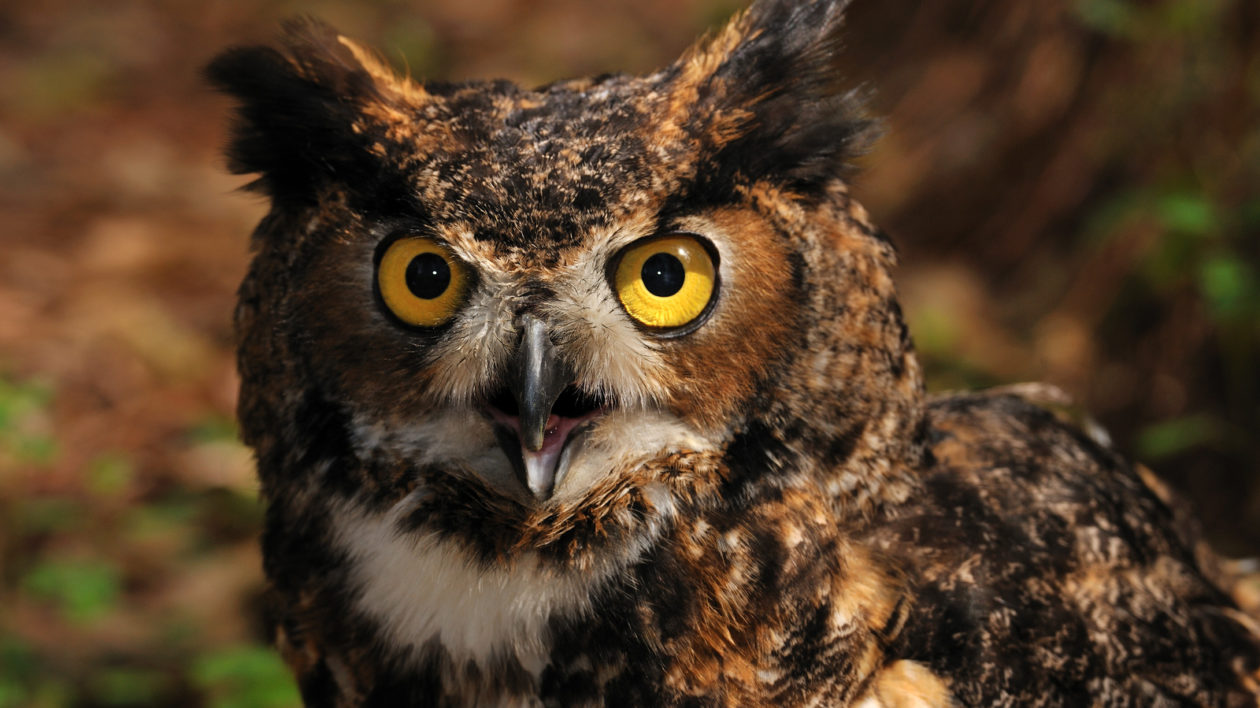
Photo © Mark Conlin, courtesy of Tallahassee Natural History Museum
My Owl Connection
Family lore holds that, long before I could utter words, I would lie in my crib and hoot like an owl. Perhaps my naturalist path was set, even then.
That story has been in my thoughts this year, as I prepare for the birth of my own son. The great horned owls, it seems, are everywhere. I see them perched on trees around our home and along the greenbelt jogging path; hear their calls in the canyons and river bottoms.
I’m always alert to the local wildlife, but this year, I can’t help but pay extra attention to all that owl activity.
I wake up in the middle of the night, thinking of my son and the world he’ll inhabit. And then, there it is: that deep hoot, hoot, hooting.
It seems to fill the room.
I snuggle under the covers and smile, filled with the hope that my son will find such comfort and joy in the wild things and their always-interesting ways.
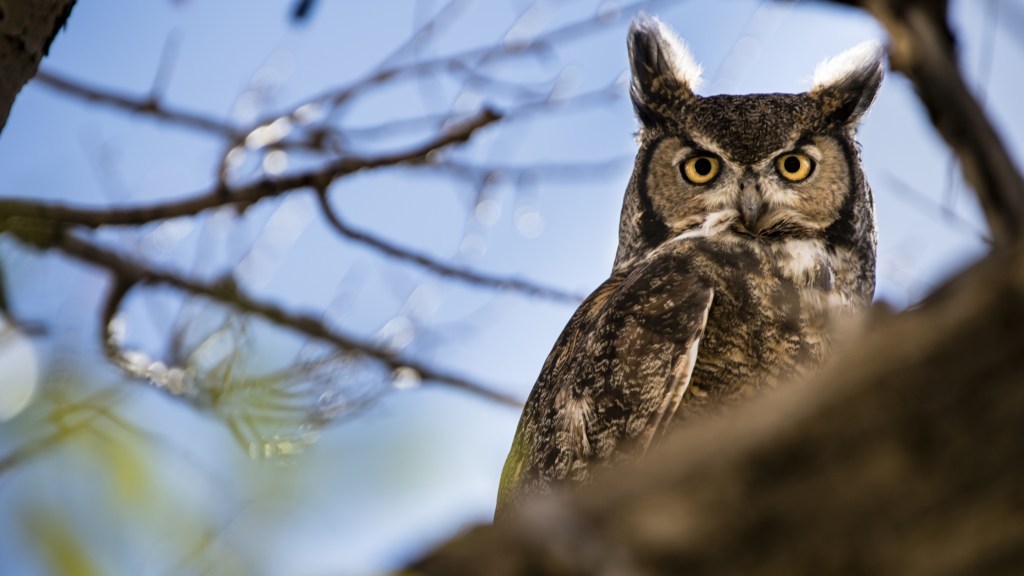



Hi
I hope you are well.
Your photos are really awesome.
I need one of your photos for the cover art of my book. That photo is an owl with the title: “The Hooting Season: Enjoying Great Horned Owls” take on DECEMBER 8, 2014.
Can I use this photo?
This book is my poem.
I have not received any money from the place for printing this book.
Warmest
Sina
Hi Sina, Thank you for the question! I believe that Nick Hall retains the copyright on that photo. You can find his contact info here: http://www.nickhallphotography.com/mobile/?p=info-contact
Thank you for the informative article. I live in Monterey County on the former Fort Ord military base, which is now California State University Monterey Bay. We have two hoots owls here that are actively hooting now in January. They sit above near by roofs and hoot to each other. Last year I read that the hooting is to establish or defend terroritory – but now – after reading this article – I wonder if they are mates. Thoughts on establishment of territory hoots versus mating hoots? Whichever it is – it is pure magic to listen to.
Rebecca
Hi Rebecca, Thank you for your interest! You might check out these sound recordings from Cornell, including territorial calls: https://www.allaboutbirds.org/guide/Great_Horned_Owl/sounds
Hi Matthew,
Thank you for the enjoyable article about Great Horned Owls. I had my interest in GHOs intrude (nicely) into my life when a pair set up housekeeping about 300 feet from my bedroom window.
I believe that you might want to make a correction, however. Since I now have GHOs as neighbors, I saw only the female GHO sit on the nest and brood the eggs. Cornell University’s website notes that only the female Great Horned Owl has a brood patch on her underside, so the male is unable to warm the eggs. (I have seen this also on the Savannah Owl nest in 2016, now an Osprey nest at: http://landingsbirdcam.com). Thus, Great Horned Owls each have a separate duty when raising a brood of owlets. The female sits the eggs and the male brings in the fresh meat.
In response to the number of posts below that discuss how owls ‘sing’ with their hooting, I am sharing a website at the International Owl Center site that provides recordings of male and female GHOs. The males have deeper voices and the females voices are higher-pitched. They are similar to humans in their gender-based voice tonality. Their sounds tell their stories:
from The International Owl center:
https://www.internationalowlcenter.org/ourowls/rustyandiris/vocalizations/heartheowls
Double check your facts about GHOs and egg brooding. It is the essence of good science. (It’s too bad that I cannot post a picture, I have some good ones of my neighbor owls.)
thanks,
Jan
Pretty cool little article. Thanks
I’ve been uo since 5 Am listening to one in a small
motte of live oaks at the edge of our yard. Its stopped right at 7 AM just as hints
of light appeared. This has been going on frequently since November 2017.
Like you I was fascinated by owls apparently as a toddler.
My mother told me many times my first words were “hoot ow”
apparently because they had a bird picture book for me to look at.
Thanks for a coll bit of writing.
Regards,
Will Fraser
retired oil and gas geoscientist
Beautiful story………I did not know they started so early in the season to nest! I awakened at 5 this morning to hooting; I loved it. This is before Thanksgiving. Saw a great horned owl here on NM for the first time in my life, right before dusk – very thrilled. I lived in central NJ for years and never saw one, but do miss the beautiful cardinals, which are not here, it seems.
I live in Central Florida. The weather is starting to warm up a lot. I have heard the sound of an animal “growling” as I walk in the very early, still dark, mornings. The growling appears to be coming from a tree. It is a hollow, vibrato of a howl; not like the growl of a dog. At first I thought it might be some type of frog…I wanted to know if you think it could be an owl. Would they build a nest in a residential area?
I have only seen an owl one time and that was in Panama.
Hi Loretta, They will nest in residential areas, so it could be an owl. Thank you for the question!
Hi Matt,I have had red tail hawks for the last 4 years in a huge pine tree in my back yard. I had a infrared camera put in the tree. 64 feet high the hawks continued refurbishing their nest it’s the middle of March I don’t think they are coming back this year,I’ve noticed on the camera a great horned Owl comes into the nest in the early morning hours an hoots an stays 15-20 minutes then flys away.Is it possible the owl may be using the hawk nest this year to raise a family this year?
If so I’m in Ga next to Tennessee Georgia state line so when do owls start nesting? I hope one or the other
start soon can’t wait to watch.
Thank You Frankie:
Thank you Matt for this article. I truly enjoyed reading it – especially the part where you express your joy upon waking in the middle of the night to the sound of a hooting Great Horned Owl! Two nights ago I too was awakened by this extrordinary blessed hooting that was coming from a few pines we have next to our bedroom window. I, like you, just lay there, snuggled under the covers, smiling and listening to this owl and thought “My what a wonderful world”!
Hi Matt,
Exactly one year ago, a stranger I met up with a stranger in the woods who noticed I was carrying a camera. She led me to a pair of fur trees where I discovered my newest feathered friend, a sleeping great horned owl. I call him Waldo as he blends in so perfectly with the tree bark, the only way to spot him is to catch a glimpse of his tufted ears. For 2 months I quietly visited Waldo and was able to capture some pretty amazing pictures. The icing on the cake was when I discovered his mate and an owlet in the same tree! I returned in December 2016 and was so happy to see Mom and Dad asleep in the same tree. But sadly, I have not seen them since. I know they never use the same nest, but these trees appeared to be their daytime resting area. I feel so sad and am worried something may have happened to them. Any thoughts?
This is a heartfelt and informational article. I’m glad I googled and found it. I hope the son you mention is beginning to toddle and explore like his father. We have a pair of owls in our backyard this year (we have before, but they seem particularly content this year). I live in a suburb but have a expansive tree lined backyard. I look forward to seeing them in the morning and in the evening. Every day when I come home from work, I sneak around my house to look for them before they flee. I love my dog, but he does sometimes scare them off. But, each day they’ve been returning. I, too, actually witnessed them mating just last week-twice! My husband finds them interesting too, but I think he humors me. My friends just don’t get it. These beautiful creatures are majestic and so highly adapted. The silent flight amazes me. I have mostly been wondering why they hoot as much as they do-sometimes long into the night if they aren’t disturbed. Anyway, I’m sorry to ramble…thank you for allowing me to express my mutual admiration for this amazing creature. And thank you for the information in your article.
This is good ! Our Local owl in brighton is behaving just as you said ! And we spotted his / her silloutte in a large oak tree through the binoculars . Thanks Matt
Rick and Cecilia , brighton , Colorado
Hi Matt… I can’t agree more the comfort it brings is wormth. I have always looked for owls but few times in life have I had the chance to see them. So it came as much surprise that while I was dosing off to sleep last night I heard the long beep hoots. One calling to another. I’ve never slept so happy in my life.
I liked this. I wake up many nights hearing two owls hooting back and forth to each one has a much deeper, almost calming hoot. while the otherone is higher pitched. I feel good when I hear them, but have a concern because I don’t know much about owls. I haven’t found their nest yet.
The Great Horned are in the woods behind my house
They have been there for a number of years
An owlet fledged into our yard.
We have a photo
We had an excellent vantage point as it flew into a leaf-bare elm and called to its parents in a loud screechy voice for mealtime.
We watched as it flew after a last visit from a parent beginning its life as a wild animal
It had been ours for 2 1/2 weeks
Beautiful large birds
Matt,
Do great horned owls come back year after year to the same hunting grounds once they
have lived in a nest and hunted there? Do their young tend to come back to the same area where they were nested? We did hear growling one night wondering where it came from, or if we heard it at all. lol
Thanks from a Mom in Illinois, whose kids didn’t have to go very far to find the owl palettes needed for their science report on owls! I love nature. It is a free show that captivated our children year round.